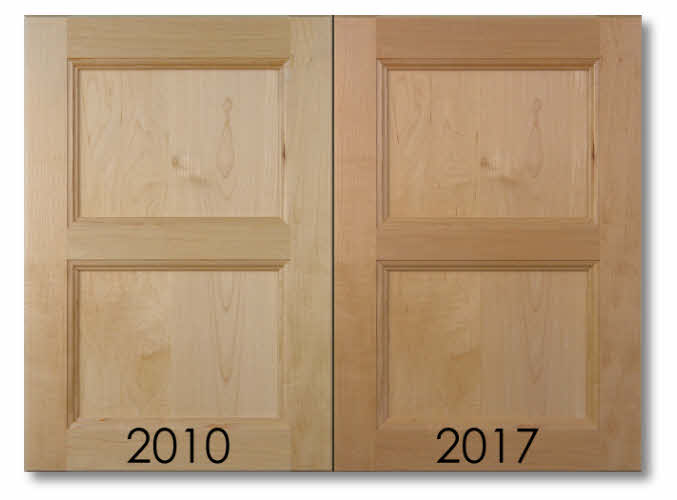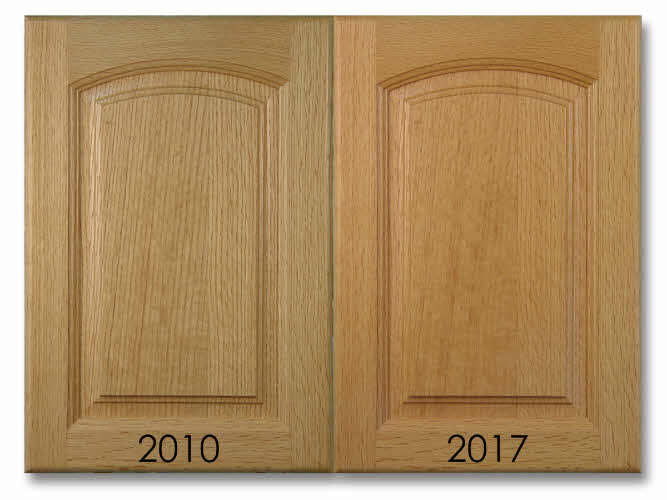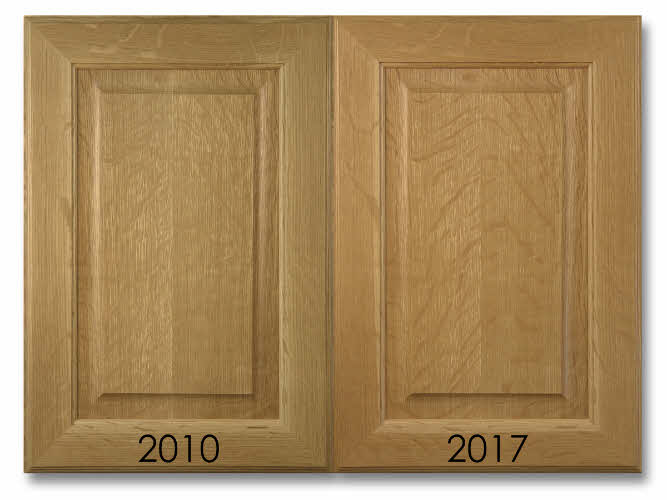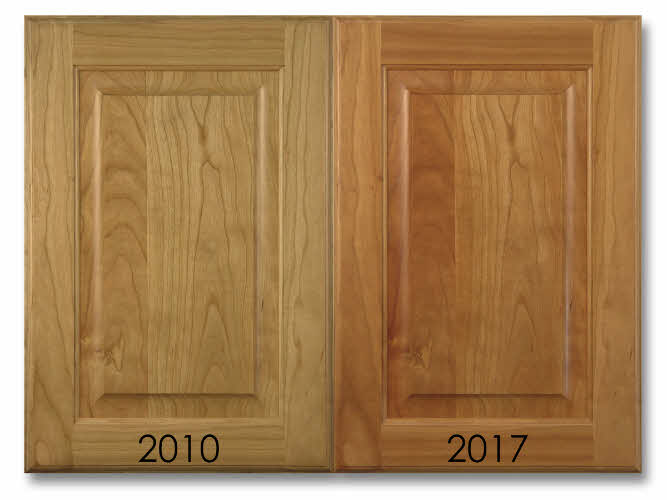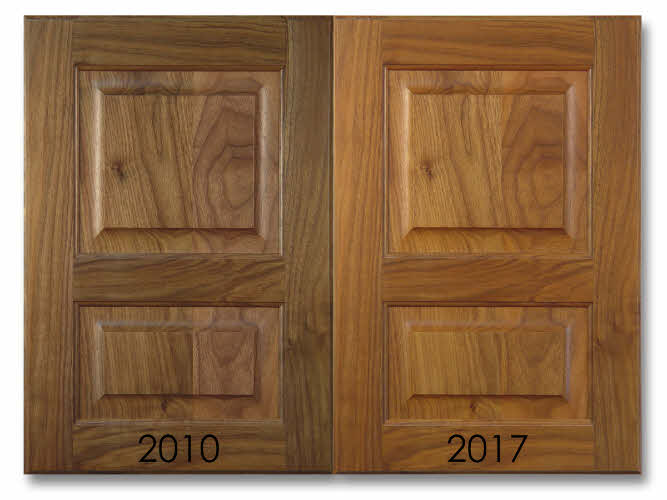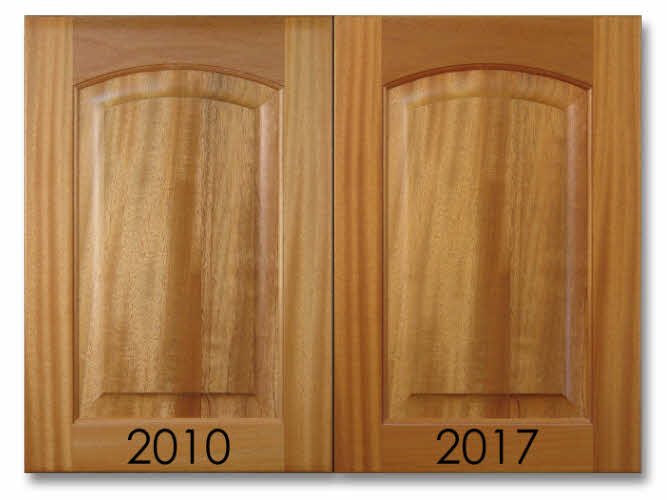Color Shift of Wood
Did you know that the color of your wooden cabinets will shift over time? If unprotected, a raw wooden surface can shift noticeably in a matter of hours. On the other hand, if reasonable precautions are taken this process will be slowed down. Despite any number of "reasonable precautions" (and really anything short of locking your furniture in a perfectly dark room with completely stable temperature and humidity) furniture and cabinetry made from real wood will change naturally over the months and years of their life. Don't worry, it's normal!
Depending on the species of wood, its finish, and the environmental factors of where it ends up - this process can be subtle or quite rapid. Some woods will lighten and others will darken, some will lose their color and some seem to become more vibrant or rich over time. Each species of wood has a different "settled" color. Wood generally follows the process of moving from its initial color and will work through its unique species' spectrum until it gets closer and closer to its "settled" color. This is usually where the shift will slow down and become somewhat stable. We can make predictions based on observations and trade knowledge, but the reality is that the wood from each tree can vary from one to the next, and there can be a pretty dramatic range of color, grain, and form even within a single tree. So, let's talk about this in some detail.
How & Why Does Wood Change?
When wood is exposed to the elements, its complicated chemical makeup is being altered, primarily through oxidation. Other than direct physical force, the four most commonly destructive forces to wooden furniture over time are LIGHT, HEAT, MOISTURE, and AIR. This is why we finish wood. At Scherr's we use a commercial grade catalyzed conversion acrylic that stays clear and is non-yellowing. A finish will protect wooden surfaces from most forms of humidity and direct exposure to air. Under normal living conditions inside of a house, and even with protected surfaces, moisture and air will still find microscopic pathways into your wood. Which is why commercial grade products, processes, and tools are superior to what is possible with a can of store-bought polyurethane and a brush. The process by which light can affect your wooden cabinets is slowed with a high quality finish, but it can not be stopped by any process that we are aware of. We all know from our science classes in grade school that heat penetrates into all matter regardless of what we do. So the lesson we have to learn is that it is only possible to slow the process of color shift in wood, not stop it. At Scherr's we have learned that after you protect your cabinets with a high quality finish, it's best to sit back and enjoy the developing character of your wooden cabinets as they shift through the spectrum that nature has granted them.
What Can I Do About Color Shift?
In addition to putting a high quality finish on the surface of your cabinets, there are reasonable precautions that a person can take to slow this process down even further:
- Avoid subjecting wood surfaces to direct sunlight
- Avoid subjecting wood surfaces to localized/direct heat sources (e.g. Ovens, Heat Lamps, Baseboard Heaters, Etc.)
- Avoid subjecting wood surfaces to conditions that are either extremely dry or too humid. (This will cause wood to either contract or swell, causing cracks and microscopic gaps to begin opening up in the finish as well as in the joinery. In extreme/very rare cases this can lead to large cracks or even structural failure of the door altogether.)
- Avoid subjecting wood surfaces to standing water or direct contact with water. Be sure to wipe any wood surfaces (finished or unfinished) dry as soon as possible.
- If/When it appears that any part of the finish on a cabinet or door/drawer has worn down to the wood, be sure to get it refinished or repaired promptly by a knowledgeable professional (refinishing wood is difficult to do correctly.)
- Keep wood surfaces away from mold, mildew, and fungi. Any mold, mildew, or fungi found in or around a wooden surface can enter (inoculate) and spread throughout the structure of the wood and alter its strength and appearance dramatically. Mold, mildew, and fungi can occur as a result of long-term exposure to damp conditions (leaks, dripping faucets, pooled water) or even from rotting fruits, vegetables, or any dead or decaying plant/animal matter.
If these precautions can not or are not followed, you can expect the wood that is exposed to any of these elements to look different than those that are not over time.
Remodeling or Building your Project in Sections
If you are particular about all of your cabinets, shelves, and furniture in the same area matching perfectly - breaking up the ordering of your project over time is not recommended. We want our Customers to be happy, and so we feel it is our duty to advise people against this.
Often have we experienced the story of Customers remodeling their kitchen with cherry cabinets and a few months/years later they order more for their "matching" kitchen island. Dismayed, they will call us up and lament about the two sections looking so different. Why would they ever look different?
- Color shift is fast and can be dramatic in some species, by the time you order the other half of your kitchen - the shift can be noticeably clear.
- One delivery of wood in our shop can (and often are) different in appearance from the next. This is because the wood that arrives in a single delivery is much more likely to come from a group of trees cut down in the same area of the same forest, they were likely milled at the same time, and they were likely kiln dried at the same time. The next batch may come from an area of a forest with different topography, different light exposure, different annual rainfall, different humidity, a slightly different species, it may be milled or kiln dried differently or may come from a different region of the world. In the same way that food coming from different regions or grown under different conditions can look and taste vastly different is an example of how so many factors are at play when it comes to what can effect the trees, their lumber, and ultimately, your cabinets.
Work WITH Nature, Not Against It!
That being said, color shift is not always undesirable. Some species of wood become more attractive as they age. Of course, this is completely subjective to the person living with the species they choose. It can only benefit you to educate yourself on what to expect from this beautiful, natural material that was once a living thing (and some would argue, still is.) There are a couple of strategies you can take when deciding on your wood choice/style that take advantage of these factors that we expect to take place.
- Choose a style of wood/construction that has color variance as a feature rather than an unintended consequence. (e.g. Some forms of Hickory are naturally two-toned, deliberately selecting wood with varying tones really make the cabinets "pop" and highlight the unique forms created by mother nature.)
- Choose to order your wood in a rustic style. Rustic cabinets have a magical way of turning defects into features. The result is charming and can result in a look and feel that is cottage or cabin-like.
- If color is very important to you, then it may be advisable to buy wood not by how it looks now, but by how you expect it to look once it reaches its "settled" color.
What exactly does a wood's settled color look like? Here is a series of photographs that we have taken to demonstrate this very thing! Each of these pictures was taken using the same doors, in the same room, using the same camera, using the same lights, even the distances and angles of the cameras/lights were recorded in 2010 so that we could recreate the same conditions in 2017. We used the same piece of background material--a neutral gray piece of melamine so that we could fine-tune the white balance and brightness. These are accurate representations of how each wood type will shift over the course of seven years. Just to give you an idea of what you're getting.
|
|
|
|
MAPLE (above) |
RED OAK (above) |
|
|
|
|
WHITE OAK (above) |
CHERRY (above) |
|
|
|
|
WALNUT (above) |
MAHOGANY (above) |
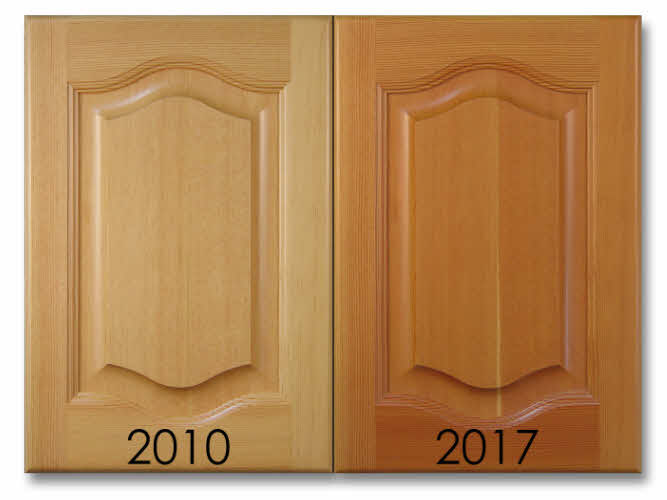

|
Fir (above) |
Birch (above) |

Red Alder (above)
.png)





